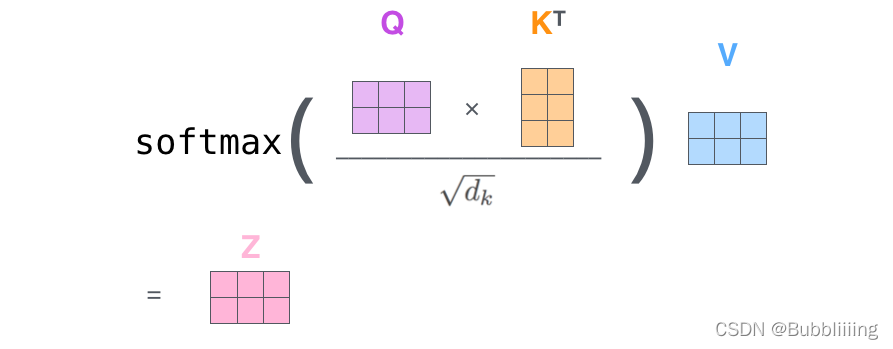神经网络学习小记录66——Vision Transformer(VIT)模型的复现详解
学习前言
视觉Transformer最近非常的火热,从VIT开始,我先学学看。
什么是Vision Transformer(VIT)
Vision Transformer是Transformer的视觉版本,Transformer基本上已经成为了自然语言处理的标配,但是在视觉中的运用还受到限制。
Vision Transformer打破了这种NLP与CV的隔离,将Transformer应用于图像图块(patch)序列上,进一步完成图像分类任务。简单来理解,Vision Transformer就是将输入进来的图片,每隔一定的区域大小划分图片块。然后将划分后的图片块组合成序列,将组合后的结果传入Transformer特有的Multi-head Self-attention进行特征提取。最后利用Cls Token进行分类。
代码下载
Github源码下载地址为:
https://github.com/bubbliiiing/classification-keras
复制该路径到地址栏跳转。
Vision Transforme的实现思路
一、整体结构解析

与寻常的分类网络类似,整个Vision Transformer可以氛围两部分,一部分是特征提取部分,另一部分是分类部分。
在特征提取部分,VIT所做的工作是特征提取。特征提取部分在图片中的对应区域是Patch+Position Embedding和Transformer Encoder。Patch+Position Embedding的作用主要是对输入进来的图片进行分块处理,每隔一定的区域大小划分图片块。然后将划分后的图片块组合成序列。在获得序列信息后,传入Transformer Encoder进行特征提取,这是Transformer特有的Multi-head Self-attention结构,通过自注意力机制,关注每个图片块的重要程度。
在分类部分,VIT所做的工作是利用提取到的特征进行分类。在进行特征提取的时候,我们会在图片序列中添加上Cls Token,该Token会作为一个单位的序列信息一起进行特征提取,提取的过程中,该Cls Token会与其它的特征进行特征交互,融合其它图片序列的特征。最终,我们利用Multi-head Self-attention结构提取特征后的Cls Token进行全连接分类。
二、网络结构解析
1、特征提取部分介绍
a、Patch+Position Embedding

Patch+Position Embedding的作用主要是对输入进来的图片进行分块处理,每隔一定的区域大小划分图片块。然后将划分后的图片块组合成序列。
该部分首先对输入进来的图片进行分块处理,处理方式其实很简单,使用的是现成的卷积。由于卷积使用的是滑动窗口的思想,我们只需要设定特定的步长,就可以输入进来的图片进行分块处理了。
在VIT中,我们常设置这个卷积的卷积核大小为16x16,步长也为16x16,此时卷积就会每隔16个像素点进行一次特征提取,由于卷积核大小为16x16,两个图片区域的特征提取过程就不会有重叠。当我们输入的图片是224, 224, 3的时候,我们可以获得一个14, 14, 768的特征层。
下一步就是将这个特征层组合成序列,组合的方式非常简单,就是将高宽维度进行平铺,14, 14, 768在高宽维度平铺后,获得一个196, 768的特征层。平铺完成后,我们会在图片序列中添加上Cls Token,该Token会作为一个单位的序列信息一起进行特征提取,图中的这个0*就是Cls Token,我们此时获得一个197, 768的特征层。
添加完成Cls Token后,再为所有特征添加上位置信息,这样网络才有区分不同区域的能力。添加方式其实也非常简单,我们生成一个197, 768的参数矩阵,这个参数矩阵是可训练的,把这个矩阵加上197, 768的特征层即可。
到这里,Patch+Position Embedding就构建完成了,构建代码如下:
#--------------------------------------------------------------------------------------------------------------------## classtoken部分是transformer的分类特征。用于堆叠到序列化后的图片特征中,作为一个单位的序列特征进行特征提取。## 在利用步长为16x16的卷积将输入图片划分成14x14的部分后,将14x14部分的特征平铺,一幅图片会存在序列长度为196的特征。# 此时生成一个classtoken,将classtoken堆叠到序列长度为196的特征上,获得一个序列长度为197的特征。# 在特征提取的过程中,classtoken会与图片特征进行特征的交互。最终分类时,我们取出classtoken的特征,利用全连接分类。#--------------------------------------------------------------------------------------------------------------------#classClassToken(Layer):def__init__(self, cls_initializer='zeros', cls_regularizer=None, cls_constraint=None,**kwargs):super(ClassToken, self).__init__(**kwargs)
self.cls_initializer = keras.initializers.get(cls_initializer)
self.cls_regularizer = keras.regularizers.get(cls_regularizer)
self.cls_constraint = keras.constraints.get(cls_constraint)defget_config(self):
config ={'cls_initializer': keras.initializers.serialize(self.cls_initializer),'cls_regularizer': keras.regularizers.serialize(self.cls_regularizer),'cls_constraint': keras.constraints.serialize(self.cls_constraint),}
base_config =super(ClassToken, self).get_config()returndict(list(base_config.items())+list(config.items()))defcompute_output_shape(self, input_shape):return(input_shape[0], input_shape[1]+1, input_shape[2])defbuild(self, input_shape):
self.num_features = input_shape[-1]
self.cls = self.add_weight(
shape =(1,1, self.num_features),
initializer = self.cls_initializer,
regularizer = self.cls_regularizer,
constraint = self.cls_constraint,
name ='cls',)super(ClassToken, self).build(input_shape)defcall(self, inputs):
batch_size = tf.shape(inputs)[0]
cls_broadcasted = tf.cast(tf.broadcast_to(self.cls,[batch_size,1, self.num_features]), dtype = inputs.dtype)return tf.concat([cls_broadcasted, inputs],1)#--------------------------------------------------------------------------------------------------------------------## 为网络提取到的特征添加上位置信息。# 以输入图片为224, 224, 3为例,我们获得的序列化后的图片特征为196, 768。加上classtoken后就是197, 768# 此时生成的pos_Embedding的shape也为197, 768,代表每一个特征的位置信息。#--------------------------------------------------------------------------------------------------------------------#classAddPositionEmbs(Layer):def__init__(self, image_shape, patch_size, pe_initializer='zeros', pe_regularizer=None, pe_constraint=None,**kwargs):super(AddPositionEmbs, self).__init__(**kwargs)
self.image_shape = image_shape
self.patch_size = patch_size
self.pe_initializer = keras.initializers.get(pe_initializer)
self.pe_regularizer = keras.regularizers.get(pe_regularizer)
self.pe_constraint = keras.constraints.get(pe_constraint)defget_config(self):
config ={'pe_initializer': keras.initializers.serialize(self.pe_initializer),'pe_regularizer': keras.regularizers.serialize(self.pe_regularizer),'pe_constraint': keras.constraints.serialize(self.pe_constraint),}
base_config =super(AddPositionEmbs, self).get_config()returndict(list(base_config.items())+list(config.items()))defcompute_output_shape(self, input_shape):return input_shape
defbuild(self, input_shape):assert(len(input_shape)==3),f"Number of dimensions should be 3, got {len(input_shape)}"
length =(224// self.patch_size)*(224// self.patch_size)+1
self.pe = self.add_weight(# shape = [1, input_shape[1], input_shape[2]],
shape =[1, length, input_shape[2]],
initializer = self.pe_initializer,
regularizer = self.pe_regularizer,
constraint = self.pe_constraint,
name ='pos_embedding',)super(AddPositionEmbs, self).build(input_shape)defcall(self, inputs):
num_features = tf.shape(inputs)[2]
cls_token_pe = self.pe[:,0:1,:]
img_token_pe = self.pe[:,1:,:]
img_token_pe = tf.reshape(img_token_pe,[1,(224// self.patch_size),(224// self.patch_size), num_features])
img_token_pe = tf.image.resize_bicubic(img_token_pe,(self.image_shape[0]// self.patch_size, self.image_shape[1]// self.patch_size), align_corners=False)
img_token_pe = tf.reshape(img_token_pe,[1,-1, num_features])
pe = tf.concat([cls_token_pe, img_token_pe], axis =1)return inputs + tf.cast(pe, dtype=inputs.dtype)defVisionTransformer(input_shape =[224,224], patch_size =16, num_layers =12, num_features =768, num_heads =12, mlp_dim =3072,
classes =1000, dropout =0.1):#-----------------------------------------------## 224, 224, 3#-----------------------------------------------#
inputs = Input(shape =(input_shape[0], input_shape[1],3))#-----------------------------------------------## 224, 224, 3 -> 14, 14, 768#-----------------------------------------------#
x = Conv2D(num_features, patch_size, strides = patch_size, padding ="valid", name ="patch_embed.proj")(inputs)#-----------------------------------------------## 14, 14, 768 -> 196, 768#-----------------------------------------------#
x = Reshape(((input_shape[0]// patch_size)*(input_shape[1]// patch_size), num_features))(x)#-----------------------------------------------## 196, 768 -> 197, 768#-----------------------------------------------#
x = ClassToken(name="cls_token")(x)#-----------------------------------------------## 197, 768 -> 197, 768#-----------------------------------------------#
x = AddPositionEmbs(input_shape, patch_size, name="pos_embed")(x)
b、Transformer Encoder

在上一步获得shape为197, 768的序列信息后,将序列信息传入Transformer Encoder进行特征提取,这是Transformer特有的Multi-head Self-attention结构,通过自注意力机制,关注每个图片块的重要程度。
I、Self-attention结构解析
看懂Self-attention结构,其实看懂下面这个动图就可以了,动图中存在一个序列的三个单位输入,每一个序列单位的输入都可以通过三个处理(比如全连接)获得Query、Key、Value,Query是查询向量、Key是键向量、Value值向量。
如果我们想要获得input-1的输出,那么我们进行如下几步:
1、利用input-1的查询向量,分别乘上input-1、input-2、input-3的键向量,此时我们获得了三个score。
2、然后对这三个score取softmax,获得了input-1、input-2、input-3各自的重要程度。
3、然后将这个重要程度乘上input-1、input-2、input-3的值向量,求和。
4、此时我们获得了input-1的输出。
如图所示,我们进行如下几步:
1、input-1的查询向量为[1, 0, 2],分别乘上input-1、input-2、input-3的键向量,获得三个score为2,4,4。
2、然后对这三个score取softmax,获得了input-1、input-2、input-3各自的重要程度,获得三个重要程度为0.0,0.5,0.5。
3、然后将这个重要程度乘上input-1、input-2、input-3的值向量,求和,即
0.0
∗
[
1
,
2
,
3
]
+
0.5
∗
[
2
,
8
,
0
]
+
0.5
∗
[
2
,
6
,
3
]
=
[
1.0
,
3.0
,
1.5
]
0.0 * [1, 2, 3] + 0.5 * [2, 8, 0] + 0.5 * [2, 6, 3] = [1.0, 3.0, 1.5]
0.0∗[1,2,3]+0.5∗[2,8,0]+0.5∗[2,6,3]=[1.0,3.0,1.5]。
4、此时我们获得了input-1的输出 [1.0, 3.0, 1.5]。
上述的例子中,序列长度仅为3,每个单位序列的特征长度仅为3,在VIT的Transformer Encoder中,序列长度为197,每个单位序列的特征长度为768 // num_heads。但计算过程是一样的。在实际运算时,我们采用矩阵进行运算。
II、Self-attention的矩阵运算
实际的矩阵运算过程如下图所示。我以实际矩阵为例子给大家解析:
输入的Query、Key、Value如下图所示:
首先利用 查询向量query 点乘 转置后的键向量key,这一步可以通俗的理解为,利用查询向量去查询序列的特征,获得序列每个部分的重要程度score。
输出的每一行,都代表input-1、input-2、input-3,对当前input的贡献,我们对这个贡献值取一个softmax。

然后利用 score 点乘 value,这一步可以通俗的理解为,将序列每个部分的重要程度重新施加到序列的值上去。
这个矩阵运算的代码如下所示,各位同学可以自己试试。
import numpy as np
defsoft_max(z):
t = np.exp(z)
a = np.exp(z)/ np.expand_dims(np.sum(t, axis=1),1)return a
Query = np.array([[1,0,2],[2,2,2],[2,1,3]])
Key = np.array([[0,1,1],[4,4,0],[2,3,1]])
Value = np.array([[1,2,3],[2,8,0],[2,6,3]])
scores = Query @ Key.T
print(scores)
scores = soft_max(scores)print(scores)
out = scores @ Value
print(out)
III、MultiHead多头注意力机制
多头注意力机制的示意图如图所示:
这幅图给人的感觉略显迷茫,我们跳脱出这个图,直接从矩阵的shape入手会清晰很多。
在第一步进行图像的分割后,我们获得的特征层为197, 768。
在施加多头的时候,我们直接对196, 768的最后一维度进行分割,比如我们想分割成12个头,那么矩阵的shepe就变成了196, 12, 64。
然后我们将196, 12, 64进行转置,将12放到前面去,获得的特征层为12, 196, 64。之后我们忽略这个12,把它和batch维度同等对待,只对196, 64进行处理,其实也就是上面的注意力机制的过程了。
#--------------------------------------------------------------------------------------------------------------------## Attention机制# 将输入的特征qkv特征进行划分,首先生成query, key, value。query是查询向量、key是键向量、v是值向量。# 然后利用 查询向量query 点乘 转置后的键向量key,这一步可以通俗的理解为,利用查询向量去查询序列的特征,获得序列每个部分的重要程度score。# 然后利用 score 点乘 value,这一步可以通俗的理解为,将序列每个部分的重要程度重新施加到序列的值上去。#--------------------------------------------------------------------------------------------------------------------#classAttention(Layer):def__init__(self, num_features, num_heads,**kwargs):super(Attention, self).__init__(**kwargs)
self.num_features = num_features
self.num_heads = num_heads
self.projection_dim = num_features // num_heads
defcompute_output_shape(self, input_shape):return(input_shape[0], input_shape[1], input_shape[2]//3)defcall(self, inputs):#-----------------------------------------------## 获得batch_size#-----------------------------------------------#
bs = tf.shape(inputs)[0]#-----------------------------------------------## b, 197, 3 * 768 -> b, 197, 3, 12, 64#-----------------------------------------------#
inputs = tf.reshape(inputs,[bs,-1,3, self.num_heads, self.projection_dim])#-----------------------------------------------## b, 197, 3, 12, 64 -> 3, b, 12, 197, 64#-----------------------------------------------#
inputs = tf.transpose(inputs,[2,0,3,1,4])#-----------------------------------------------## 将query, key, value划分开# query b, 12, 197, 64# key b, 12, 197, 64# value b, 12, 197, 64#-----------------------------------------------#
query, key, value = inputs[0], inputs[1], inputs[2]#-----------------------------------------------## b, 12, 197, 64 @ b, 12, 197, 64 = b, 12, 197, 197#-----------------------------------------------#
score = tf.matmul(query, key, transpose_b=True)#-----------------------------------------------## 进行数量级的缩放#-----------------------------------------------#
scaled_score = score / tf.math.sqrt(tf.cast(self.projection_dim, score.dtype))#-----------------------------------------------## b, 12, 197, 197 -> b, 12, 197, 197#-----------------------------------------------#
weights = tf.nn.softmax(scaled_score, axis=-1)#-----------------------------------------------## b, 12, 197, 197 @ b, 12, 197, 64 = b, 12, 197, 64#-----------------------------------------------#
value = tf.matmul(weights, value)#-----------------------------------------------## b, 12, 197, 64 -> b, 197, 12, 64#-----------------------------------------------#
value = tf.transpose(value, perm=[0,2,1,3])#-----------------------------------------------## b, 197, 12, 64 -> b, 197, 768#-----------------------------------------------#
output = tf.reshape(value,(tf.shape(value)[0], tf.shape(value)[1],-1))return output
defMultiHeadSelfAttention(inputs, num_features, num_heads, dropout, name):#-----------------------------------------------## qkv b, 197, 768 -> b, 197, 3 * 768#-----------------------------------------------#
qkv = Dense(int(num_features *3), name = name +"qkv")(inputs)#-----------------------------------------------## b, 197, 3 * 768 -> b, 197, 768#-----------------------------------------------#
x = Attention(num_features, num_heads)(qkv)#-----------------------------------------------## 197, 768 -> 197, 768#-----------------------------------------------#
x = Dense(num_features, name = name +"proj")(x)
x = Dropout(dropout)(x)return x
IV、TransformerBlock的构建。

在完成MultiHeadSelfAttention的构建后,我们需要在其后加上两个全连接。就构建了整个TransformerBlock。
defMLP(y, num_features, mlp_dim, dropout, name):
y = Dense(mlp_dim, name = name +"fc1")(y)
y = Gelu()(y)
y = Dropout(dropout)(y)
y = Dense(num_features, name = name +"fc2")(y)return y
defTransformerBlock(inputs, num_features, num_heads, mlp_dim, dropout, name):#-----------------------------------------------## 施加层标准化#-----------------------------------------------#
x = LayerNormalization(epsilon=1e-6, name = name +"norm1")(inputs)#-----------------------------------------------## 施加多头注意力机制#-----------------------------------------------#
x = MultiHeadSelfAttention(x, num_features, num_heads, dropout, name = name +"attn.")
x = Dropout(dropout)(x)#-----------------------------------------------## 施加残差结构#-----------------------------------------------#
x = Add()([x, inputs])#-----------------------------------------------## 施加层标准化#-----------------------------------------------#
y = LayerNormalization(epsilon=1e-6, name = name +"norm2")(x)#-----------------------------------------------## 施加两次全连接#-----------------------------------------------#
y = MLP(y, num_features, mlp_dim, dropout, name = name +"mlp.")
y = Dropout(dropout)(y)#-----------------------------------------------## 施加残差结构#-----------------------------------------------#
y = Add()([x, y])return y
c、整个VIT模型的构建

整个VIT模型由一个Patch+Position Embedding加上多个TransformerBlock组成。典型的TransforerBlock的数量为12个。
defVisionTransformer(input_shape =[224,224], patch_size =16, num_layers =12, num_features =768, num_heads =12, mlp_dim =3072,
classes =1000, dropout =0.1):#-----------------------------------------------## 224, 224, 3#-----------------------------------------------#
inputs = Input(shape =(input_shape[0], input_shape[1],3))#-----------------------------------------------## 224, 224, 3 -> 14, 14, 768#-----------------------------------------------#
x = Conv2D(num_features, patch_size, strides = patch_size, padding ="valid", name ="patch_embed.proj")(inputs)#-----------------------------------------------## 14, 14, 768 -> 196, 768#-----------------------------------------------#
x = Reshape(((input_shape[0]// patch_size)*(input_shape[1]// patch_size), num_features))(x)#-----------------------------------------------## 196, 768 -> 197, 768#-----------------------------------------------#
x = ClassToken(name="cls_token")(x)#-----------------------------------------------## 197, 768 -> 197, 768#-----------------------------------------------#
x = AddPositionEmbs(input_shape, patch_size, name="pos_embed")(x)#-----------------------------------------------## 197, 768 -> 197, 768 12次#-----------------------------------------------#for n inrange(num_layers):
x = TransformerBlock(
x,
num_features= num_features,
num_heads = num_heads,
mlp_dim = mlp_dim,
dropout = dropout,
name ="blocks."+str(n)+".",)
x = LayerNormalization(
epsilon=1e-6, name="norm")(x)
2、分类部分

在分类部分,VIT所做的工作是利用提取到的特征进行分类。
在进行特征提取的时候,我们会在图片序列中添加上Cls Token,该Token会作为一个单位的序列信息一起进行特征提取,提取的过程中,该Cls Token会与其它的特征进行特征交互,融合其它图片序列的特征。
最终,我们利用Multi-head Self-attention结构提取特征后的Cls Token进行全连接分类。
defVisionTransformer(input_shape =[224,224], patch_size =16, num_layers =12, num_features =768, num_heads =12, mlp_dim =3072,
classes =1000, dropout =0.1):#-----------------------------------------------## 224, 224, 3#-----------------------------------------------#
inputs = Input(shape =(input_shape[0], input_shape[1],3))#-----------------------------------------------## 224, 224, 3 -> 14, 14, 768#-----------------------------------------------#
x = Conv2D(num_features, patch_size, strides = patch_size, padding ="valid", name ="patch_embed.proj")(inputs)#-----------------------------------------------## 14, 14, 768 -> 196, 768#-----------------------------------------------#
x = Reshape(((input_shape[0]// patch_size)*(input_shape[1]// patch_size), num_features))(x)#-----------------------------------------------## 196, 768 -> 197, 768#-----------------------------------------------#
x = ClassToken(name="cls_token")(x)#-----------------------------------------------## 197, 768 -> 197, 768#-----------------------------------------------#
x = AddPositionEmbs(input_shape, patch_size, name="pos_embed")(x)#-----------------------------------------------## 197, 768 -> 197, 768 12次#-----------------------------------------------#for n inrange(num_layers):
x = TransformerBlock(
x,
num_features= num_features,
num_heads = num_heads,
mlp_dim = mlp_dim,
dropout = dropout,
name ="blocks."+str(n)+".",)
x = LayerNormalization(
epsilon=1e-6, name="norm")(x)
x = Lambda(lambda v: v[:,0], name="ExtractToken")(x)
x = Dense(classes, name="head")(x)
x = Softmax()(x)return keras.models.Model(inputs, x)
Vision Transforme的构建代码
import math
import keras
import tensorflow as tf
from keras import backend as K
from keras.layers import(Add, Conv2D, Dense, Dropout, Input, Lambda, Layer,
Reshape, Softmax)#--------------------------------------## LayerNormalization# 层标准化的实现#--------------------------------------#classLayerNormalization(keras.layers.Layer):def__init__(self,
center=True,
scale=True,
epsilon=None,
gamma_initializer='ones',
beta_initializer='zeros',
gamma_regularizer=None,
beta_regularizer=None,
gamma_constraint=None,
beta_constraint=None,**kwargs):"""Layer normalization layer
See: [Layer Normalization](https://arxiv.org/pdf/1607.06450.pdf)
:param center: Add an offset parameter if it is True.
:param scale: Add a scale parameter if it is True.
:param epsilon: Epsilon for calculating variance.
:param gamma_initializer: Initializer for the gamma weight.
:param beta_initializer: Initializer for the beta weight.
:param gamma_regularizer: Optional regularizer for the gamma weight.
:param beta_regularizer: Optional regularizer for the beta weight.
:param gamma_constraint: Optional constraint for the gamma weight.
:param beta_constraint: Optional constraint for the beta weight.
:param kwargs:
"""super(LayerNormalization, self).__init__(**kwargs)
self.supports_masking =True
self.center = center
self.scale = scale
if epsilon isNone:
epsilon = K.epsilon()* K.epsilon()
self.epsilon = epsilon
self.gamma_initializer = keras.initializers.get(gamma_initializer)
self.beta_initializer = keras.initializers.get(beta_initializer)
self.gamma_regularizer = keras.regularizers.get(gamma_regularizer)
self.beta_regularizer = keras.regularizers.get(beta_regularizer)
self.gamma_constraint = keras.constraints.get(gamma_constraint)
self.beta_constraint = keras.constraints.get(beta_constraint)
self.gamma, self.beta =None,Nonedefget_config(self):
config ={'center': self.center,'scale': self.scale,'epsilon': self.epsilon,'gamma_initializer': keras.initializers.serialize(self.gamma_initializer),'beta_initializer': keras.initializers.serialize(self.beta_initializer),'gamma_regularizer': keras.regularizers.serialize(self.gamma_regularizer),'beta_regularizer': keras.regularizers.serialize(self.beta_regularizer),'gamma_constraint': keras.constraints.serialize(self.gamma_constraint),'beta_constraint': keras.constraints.serialize(self.beta_constraint),}
base_config =super(LayerNormalization, self).get_config()returndict(list(base_config.items())+list(config.items()))defcompute_output_shape(self, input_shape):return input_shape
defcompute_mask(self, inputs, input_mask=None):return input_mask
defbuild(self, input_shape):
shape = input_shape[-1:]if self.scale:
self.gamma = self.add_weight(
shape=shape,
initializer=self.gamma_initializer,
regularizer=self.gamma_regularizer,
constraint=self.gamma_constraint,
name='gamma',)if self.center:
self.beta = self.add_weight(
shape=shape,
initializer=self.beta_initializer,
regularizer=self.beta_regularizer,
constraint=self.beta_constraint,
name='beta',)super(LayerNormalization, self).build(input_shape)defcall(self, inputs, training=None):
mean = K.mean(inputs, axis=-1, keepdims=True)
variance = K.mean(K.square(inputs - mean), axis=-1, keepdims=True)
std = K.sqrt(variance + self.epsilon)
outputs =(inputs - mean)/ std
if self.scale:
outputs *= self.gamma
if self.center:
outputs += self.beta
return outputs
#--------------------------------------## Gelu激活函数的实现# 利用近似的数学公式#--------------------------------------#classGelu(Layer):def__init__(self,**kwargs):super(Gelu, self).__init__(**kwargs)
self.supports_masking =Truedefcall(self, inputs):return0.5* inputs *(1+ tf.tanh(tf.sqrt(2/ math.pi)*(inputs +0.044715* tf.pow(inputs,3))))defget_config(self):
config =super(Gelu, self).get_config()return config
defcompute_output_shape(self, input_shape):return input_shape
#--------------------------------------------------------------------------------------------------------------------## classtoken部分是transformer的分类特征。用于堆叠到序列化后的图片特征中,作为一个单位的序列特征进行特征提取。## 在利用步长为16x16的卷积将输入图片划分成14x14的部分后,将14x14部分的特征平铺,一幅图片会存在序列长度为196的特征。# 此时生成一个classtoken,将classtoken堆叠到序列长度为196的特征上,获得一个序列长度为197的特征。# 在特征提取的过程中,classtoken会与图片特征进行特征的交互。最终分类时,我们取出classtoken的特征,利用全连接分类。#--------------------------------------------------------------------------------------------------------------------#classClassToken(Layer):def__init__(self, cls_initializer='zeros', cls_regularizer=None, cls_constraint=None,**kwargs):super(ClassToken, self).__init__(**kwargs)
self.cls_initializer = keras.initializers.get(cls_initializer)
self.cls_regularizer = keras.regularizers.get(cls_regularizer)
self.cls_constraint = keras.constraints.get(cls_constraint)defget_config(self):
config ={'cls_initializer': keras.initializers.serialize(self.cls_initializer),'cls_regularizer': keras.regularizers.serialize(self.cls_regularizer),'cls_constraint': keras.constraints.serialize(self.cls_constraint),}
base_config =super(ClassToken, self).get_config()returndict(list(base_config.items())+list(config.items()))defcompute_output_shape(self, input_shape):return(input_shape[0], input_shape[1]+1, input_shape[2])defbuild(self, input_shape):
self.num_features = input_shape[-1]
self.cls = self.add_weight(
shape =(1,1, self.num_features),
initializer = self.cls_initializer,
regularizer = self.cls_regularizer,
constraint = self.cls_constraint,
name ='cls',)super(ClassToken, self).build(input_shape)defcall(self, inputs):
batch_size = tf.shape(inputs)[0]
cls_broadcasted = tf.cast(tf.broadcast_to(self.cls,[batch_size,1, self.num_features]), dtype = inputs.dtype)return tf.concat([cls_broadcasted, inputs],1)#--------------------------------------------------------------------------------------------------------------------## 为网络提取到的特征添加上位置信息。# 以输入图片为224, 224, 3为例,我们获得的序列化后的图片特征为196, 768。加上classtoken后就是197, 768# 此时生成的pos_Embedding的shape也为197, 768,代表每一个特征的位置信息。#--------------------------------------------------------------------------------------------------------------------#classAddPositionEmbs(Layer):def__init__(self, image_shape, patch_size, pe_initializer='zeros', pe_regularizer=None, pe_constraint=None,**kwargs):super(AddPositionEmbs, self).__init__(**kwargs)
self.image_shape = image_shape
self.patch_size = patch_size
self.pe_initializer = keras.initializers.get(pe_initializer)
self.pe_regularizer = keras.regularizers.get(pe_regularizer)
self.pe_constraint = keras.constraints.get(pe_constraint)defget_config(self):
config ={'pe_initializer': keras.initializers.serialize(self.pe_initializer),'pe_regularizer': keras.regularizers.serialize(self.pe_regularizer),'pe_constraint': keras.constraints.serialize(self.pe_constraint),}
base_config =super(AddPositionEmbs, self).get_config()returndict(list(base_config.items())+list(config.items()))defcompute_output_shape(self, input_shape):return input_shape
defbuild(self, input_shape):assert(len(input_shape)==3),f"Number of dimensions should be 3, got {len(input_shape)}"
length =(224// self.patch_size)*(224// self.patch_size)+1
self.pe = self.add_weight(# shape = [1, input_shape[1], input_shape[2]],
shape =[1, length, input_shape[2]],
initializer = self.pe_initializer,
regularizer = self.pe_regularizer,
constraint = self.pe_constraint,
name ='pos_embedding',)super(AddPositionEmbs, self).build(input_shape)defcall(self, inputs):
num_features = tf.shape(inputs)[2]
cls_token_pe = self.pe[:,0:1,:]
img_token_pe = self.pe[:,1:,:]
img_token_pe = tf.reshape(img_token_pe,[1,(224// self.patch_size),(224// self.patch_size), num_features])
img_token_pe = tf.image.resize_bicubic(img_token_pe,(self.image_shape[0]// self.patch_size, self.image_shape[1]// self.patch_size), align_corners=False)
img_token_pe = tf.reshape(img_token_pe,[1,-1, num_features])
pe = tf.concat([cls_token_pe, img_token_pe], axis =1)return inputs + tf.cast(pe, dtype=inputs.dtype)#--------------------------------------------------------------------------------------------------------------------## Attention机制# 将输入的特征qkv特征进行划分,首先生成query, key, value。query是查询向量、key是键向量、v是值向量。# 然后利用 查询向量query 点乘 转置后的键向量key,这一步可以通俗的理解为,利用查询向量去查询序列的特征,获得序列每个部分的重要程度score。# 然后利用 score 点乘 value,这一步可以通俗的理解为,将序列每个部分的重要程度重新施加到序列的值上去。#--------------------------------------------------------------------------------------------------------------------#classAttention(Layer):def__init__(self, num_features, num_heads,**kwargs):super(Attention, self).__init__(**kwargs)
self.num_features = num_features
self.num_heads = num_heads
self.projection_dim = num_features // num_heads
defcompute_output_shape(self, input_shape):return(input_shape[0], input_shape[1], input_shape[2]//3)defcall(self, inputs):#-----------------------------------------------## 获得batch_size#-----------------------------------------------#
bs = tf.shape(inputs)[0]#-----------------------------------------------## b, 197, 3 * 768 -> b, 197, 3, 12, 64#-----------------------------------------------#
inputs = tf.reshape(inputs,[bs,-1,3, self.num_heads, self.projection_dim])#-----------------------------------------------## b, 197, 3, 12, 64 -> 3, b, 12, 197, 64#-----------------------------------------------#
inputs = tf.transpose(inputs,[2,0,3,1,4])#-----------------------------------------------## 将query, key, value划分开# query b, 12, 197, 64# key b, 12, 197, 64# value b, 12, 197, 64#-----------------------------------------------#
query, key, value = inputs[0], inputs[1], inputs[2]#-----------------------------------------------## b, 12, 197, 64 @ b, 12, 197, 64 = b, 12, 197, 197#-----------------------------------------------#
score = tf.matmul(query, key, transpose_b=True)#-----------------------------------------------## 进行数量级的缩放#-----------------------------------------------#
scaled_score = score / tf.math.sqrt(tf.cast(self.projection_dim, score.dtype))#-----------------------------------------------## b, 12, 197, 197 -> b, 12, 197, 197#-----------------------------------------------#
weights = tf.nn.softmax(scaled_score, axis=-1)#-----------------------------------------------## b, 12, 197, 197 @ b, 12, 197, 64 = b, 12, 197, 64#-----------------------------------------------#
value = tf.matmul(weights, value)#-----------------------------------------------## b, 12, 197, 64 -> b, 197, 12, 64#-----------------------------------------------#
value = tf.transpose(value, perm=[0,2,1,3])#-----------------------------------------------## b, 197, 12, 64 -> b, 197, 768#-----------------------------------------------#
output = tf.reshape(value,(tf.shape(value)[0], tf.shape(value)[1],-1))return output
defMultiHeadSelfAttention(inputs, num_features, num_heads, dropout, name):#-----------------------------------------------## qkv b, 197, 768 -> b, 197, 3 * 768#-----------------------------------------------#
qkv = Dense(int(num_features *3), name = name +"qkv")(inputs)#-----------------------------------------------## b, 197, 3 * 768 -> b, 197, 768#-----------------------------------------------#
x = Attention(num_features, num_heads)(qkv)#-----------------------------------------------## 197, 768 -> 197, 768#-----------------------------------------------#
x = Dense(num_features, name = name +"proj")(x)
x = Dropout(dropout)(x)return x
defMLP(y, num_features, mlp_dim, dropout, name):
y = Dense(mlp_dim, name = name +"fc1")(y)
y = Gelu()(y)
y = Dropout(dropout)(y)
y = Dense(num_features, name = name +"fc2")(y)return y
defTransformerBlock(inputs, num_features, num_heads, mlp_dim, dropout, name):#-----------------------------------------------## 施加层标准化#-----------------------------------------------#
x = LayerNormalization(epsilon=1e-6, name = name +"norm1")(inputs)#-----------------------------------------------## 施加多头注意力机制#-----------------------------------------------#
x = MultiHeadSelfAttention(x, num_features, num_heads, dropout, name = name +"attn.")
x = Dropout(dropout)(x)#-----------------------------------------------## 施加残差结构#-----------------------------------------------#
x = Add()([x, inputs])#-----------------------------------------------## 施加层标准化#-----------------------------------------------#
y = LayerNormalization(epsilon=1e-6, name = name +"norm2")(x)#-----------------------------------------------## 施加两次全连接#-----------------------------------------------#
y = MLP(y, num_features, mlp_dim, dropout, name = name +"mlp.")
y = Dropout(dropout)(y)#-----------------------------------------------## 施加残差结构#-----------------------------------------------#
y = Add()([x, y])return y
defVisionTransformer(input_shape =[224,224], patch_size =16, num_layers =12, num_features =768, num_heads =12, mlp_dim =3072,
classes =1000, dropout =0.1):#-----------------------------------------------## 224, 224, 3#-----------------------------------------------#
inputs = Input(shape =(input_shape[0], input_shape[1],3))#-----------------------------------------------## 224, 224, 3 -> 14, 14, 768#-----------------------------------------------#
x = Conv2D(num_features, patch_size, strides = patch_size, padding ="valid", name ="patch_embed.proj")(inputs)#-----------------------------------------------## 14, 14, 768 -> 196, 768#-----------------------------------------------#
x = Reshape(((input_shape[0]// patch_size)*(input_shape[1]// patch_size), num_features))(x)#-----------------------------------------------## 196, 768 -> 197, 768#-----------------------------------------------#
x = ClassToken(name="cls_token")(x)#-----------------------------------------------## 197, 768 -> 197, 768#-----------------------------------------------#
x = AddPositionEmbs(input_shape, patch_size, name="pos_embed")(x)#-----------------------------------------------## 197, 768 -> 197, 768 12次#-----------------------------------------------#for n inrange(num_layers):
x = TransformerBlock(
x,
num_features= num_features,
num_heads = num_heads,
mlp_dim = mlp_dim,
dropout = dropout,
name ="blocks."+str(n)+".",)
x = LayerNormalization(
epsilon=1e-6, name="norm")(x)
x = Lambda(lambda v: v[:,0], name="ExtractToken")(x)
x = Dense(classes, name="head")(x)
x = Softmax()(x)return keras.models.Model(inputs, x)
版权归原作者 Bubbliiiing 所有, 如有侵权,请联系我们删除。